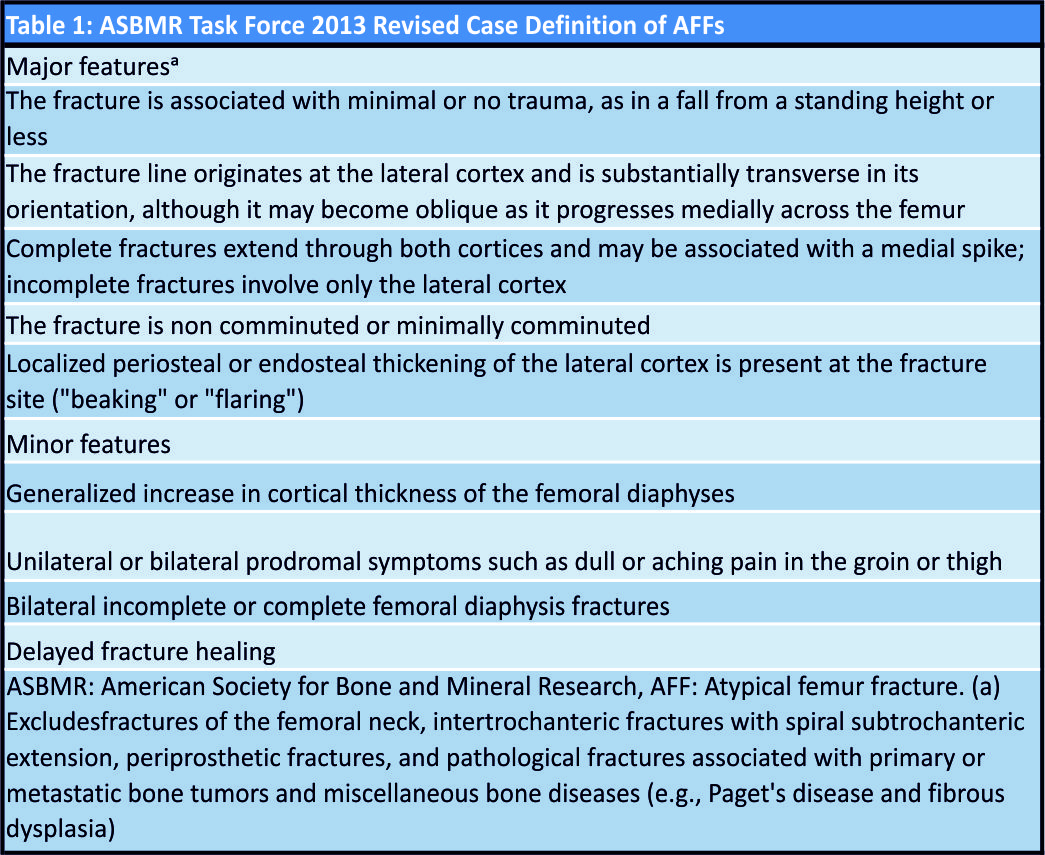[box type=”bio”] Learning Point for the Article: [/box]
Peri-implant atypical fractures associated with bisphosphonates should be considered as a possible variation of atypical femur fractures,since the presented cases suggest that the mechanical factors associated with the implants appear to be insufficient to explain such lesions.
Case Report | Volume 8 | Issue 4 | JOCR July – August 2018 | Page 66-69| Nuno Duarte Simões, Zico Gonçalves, João Moreno, Frederico Paiva, Serafim Pinho, Miguel Varzielas. DOI: 10.13107/jocr.2250-0685.1164
Authors: Nuno Duarte Simões[1], Zico Gonçalves[1], João Moreno[1], Frederico Paiva[1], Serafim Pinho[1], Miguel Varzielas[1]
[1]Department of Orthopaedics, Centro-Hospitalar Tondela-Viseu, Portugal, Av. Rei D. Duarte, 3504 509 – Viseu, Portugal.
Address of Correspondence:
Dr. Nuno Duarte Simões,
Department of Orthopaedics, Centro-Hospitalar Tondela-Viseu, Av. Rei D. Duarte, 3504 509 – Viseu, Portugal.
E-mail: simoescc@hotmail.com
Abstract
Introduction: In recent years, growing evidence of the association between bisphosphonate use and incidence of atypical femoral fractures has emerged. Cases of peri-implant fractures associated with bisphosphonate use suggest the emergence of a new clinical entity because they are not currently covered by the definition of atypical femoral fracture.
Case Report: We present here two rare clinical cases treated in our hospital. Two women (68 and 76 years old) with peri-implant (cephalomedullary nail) fractures and history of prolonged bisphosphonate use (11 and 14 years). Both fractures occurred after minor trauma and showed an atypical fracture pattern. One of the patients underwent revision osteosynthesis and had a 12 months follow-up. The second patient was submitted to orthopedic treatment and had a 6months follow-up.
Conclusion: Although reports of periprosthetic fractures and peri-implant(plate and screws) have been published, references to peri-implant cephalomedullary nail fractures were not found in the literature. Here, we question if these fracture types should be included in the current definition of atypical femoral fracture, or form a new clinical entity.
Keywords: Peri-implant fracture, Bisphosphonate, Atypical femoral fracture.
Introduction
The therapeutic effects of bisphosphonates result from its antiresorptive activity in the bone, which reduces the number of new osteoclasts, decreases osteoclasts activity, and stimulates apoptosis of this kind of cells, with consequent bone turnover reduction. Strong and prolonged inhibition deregulates the normal turnover of bone, inducing a bone remineralization process, which increases its rigidity, leading to “frozen bone,” and microcrack accumulation, which may progress to fatigue fractures, in the absence of proper remodeling [1]. Despite these data, other studies showed increased bone stock and longer implant survival with bisphosphonate use after knee and hip arthroplasty [2, 3]. Multiple publications have recently associated bisphosphonate use with the emergence of atypical subtrochanteric and shaft fractures of the femur. These are more common after continued use of this medication for 2 years, and up to a year after the last prescription [4,5, 6]. Schilcher et al. [7] stated that the risk is higher in women and those using alendronate. However, this association was recognized only in 2014, in the Second Report of the American Society for Bone and Mineral Research Task Force, with obvious doubts regarding its strength and magnitude. Prolonged bisphosphonate use has been postulated to be associated with a relative increased risk, but the absolute risk is still low. In a latter study, periprosthetic and peri-implant fractures remain excluded from the definition of atypical femoral fracture.
Materials and Methods
We present two clinical cases of patients treated in our department that showed peri-implant femoral fractures associated with long-term bisphosphonate (alendronate) use after low-energy trauma. The clinical and radiological study, treatment, follow-up, and complications are documented in this article.
Result
Case 1
We present a 68-year-old woman, with osteoporosis, treated with bisphosphonates for 11 years and a history of left subtrochanteric fracture 3 years ago, treated with short cephalomedullary nailing. She experienced sudden pain in the left thigh while walking around with subsequent fall from standing height with the trauma of the right hemibody. She presented in the emergency room with left hip pain, not being able to walk and with no neurovascular alterations. The radiograph showed a bilateral atypical diaphyseal fracture in the femurs. In the previously intervened limb, the peri-implant fracture was located on the tip of the nail, immediately after the distal screw and with minimal comminution. Bilateral femoral cortical thickening was also evident (Fig. 1). The patient underwent long anterograde blocked bilateral nailing, which occurred without complications. Intake of alendronate, calcium and Vitamin D supplements was suspended(Fig. 2, 3). Subsequently, the patient was followed up without complications. She was discharged after 1-year surveillance.
Case 2
We present a 76-year-old woman, with a history of bisphosphonate intake for 14 years, a subtrochanteric fracture of the left femur 10 years prior treated with long cephalomedullary nailing. The patient, who had intermittent pain in the left thigh while walking in the past few weeks, went to the emergency service after a low energy fall with left hip injury and pain aggravation. Nonetheless, the radiographic study did not display any injury (Fig. 4). She returned after 3 days because pain persisted, and the X-ray showed an atypical peri-implant femoral shaft fracture, without nail fracture, after new imaging examinations were performed (Fig. 5, 6). Conservative treatment was chosen, together with no weight bearing, walking with crutches and analgesics. The patient reported clinical improvement during follow-up, 6 weeks after. Nonetheless, radiographically, she displayed failure of osteosynthesis material with cephalomedullary nail fracture, but with bone callus formation (Fig. 7). Maintenance of an expectant attitude and close monitoring during consultation were chosen(Fig. 8, 9). Currently, the patient walks and remains asymptomatic, with consolidation without fracture displacement after 6 months.
Discussion
The American Society for Bone and Mineral Research defines atypical subtrochanteric or diaphyseal fracture of the femur as those that meet four of the five major criteria and without mandatory compliance to minor criteria, as shown in Table 1 [8]. As we can see among the exceptions, periprosthetic fractures are excluded from this definition. No references are found for other metallic implants. The only study that we found in our research addressing the existence of fractures associated with osteosynthesis implants only refers to plates and screws. This is a series of 11 atypical fractures in patients treated with a system of plates and screws. We may be dealing with a new clinical entity called peri-implant fracture associated with bisphosphonates. They consider that the atypical fractures may also occur in arthroplasties and constructs with plates and screws. Intramedullary implants are not considered in this publication [9]. The existence of other confounding factors, such as stress shielding, decrease of the blood supply in the cortical bone adjacent to the plate, and changes of stiffness in the tips of the plates should be studied to assess the degree of influence of bisphosphonates in this fracture type. The use of intramedullary implants would seem to reduce external mechanic factors because they offer a more homogenous distribution of forces of stress than osteosynthesis with plate and screws. Case 2 is a paradigmatic example of what we consider to be a peri-implant fracture associated with bisphosphonates. This patient with prodromal pain, who after low-energy trauma, develops an atypical fracture in a bone with stigmata from prolonged bisphosphonate use. The location is unusual (middle third of the nail) and apparently more protected from mechanical stress factors. No similar case was found in the literature. The bilateral trend among these fractures and the delay in consolidation suggest intrinsic alterations in the bone morphology beyond local mechanical stress factors. Atypical femoral fractures tend to be located more often in the lateral cortical subtrochanteric where the tension forces are higher [10]. Vascularization of this femoral region is less developed compared with others, notably in the intertrochanteric portion, which may decrease bone regeneration ability. The implants concentrate stress within their proximal and distal limits, altering anatomical tension forces and turning plaque bone joints into weak points, subjecting these assembly boundary areas to greater tension forces, thus causing successive microlesions in an altered bone without the usual regeneration power. Lee et al. [9] proposed the use of long intramedullary implants to solve this problem.
Conclusion
This study continues a growing trend for publication of cases of atypical peri-implant and periprosthetic fractures associated with long-term bisphosphonate use. We did not find cases of similar characteristics in the literature, and there is no established association between these drugs and the described lesions. Further biomechanical studies are also needed. However, we believe that this study provides pertinent information to understand these lesions from a physiopathological point of view, and acknowledges this as a probable new clinical entity, resulting from the consequence of medical activity in contemporary society.
Clinical Message
Bisphosphonate use should be managed carefully because it might deregulate the normal turnover of bone leading to fatigue fractures, in the absence of proper remodeling. We suggest that these changes could affect the implant survival and new strategies should be created to improve our knowledge on the biomechanical and physiological factors that affect this kind of patients.
References
1. Black DM, Cummings, SR, Karpf DB, et al: Randomised trial of effect of alendronate on risk of fracture in women with existing vertebral fractures. Fracture Intervention Trial Research Group. Lancet 1996;348:1535-1541.
2. Bhandari M, Bajammal S, Guyatt GH, et al: Effect of bisphosphonates on periprosthetic bone mineral density after total joint arthroplasty. A metanalysis. J Bone Joint Surg Am 2005;87(2):293-301.
3. Koch F, Eckhardt C, Alabre CI, et al: Anabolic effects of bisphosphonates on periimplant bone stock. Biomaterials 2007;28(24)3549-59.
4. Goh SK, Yang KY, Koh JS, et al. Subtrochanteric insufficiency fractures in patients on alendronate therapy: A caution. J Bone Joint Surg Br 2007;89(3):349-353.
5. Isaacs JD, Shidiak L, Harris IA, SzomorZl: Femoral insufficiency fractures in patients associated with prolonged bisphosphonates therapy. Clin OrthopRelat Res 2010;468(12):3384-3392.
6. Schilcher JF, Attarian DE, Wellman SS: Periprosthetic femoral insufficiency fracture in a patient on long-term bisphosphonates therapy. Duke Orthop J 2012;2(1):66-69.
7. Schilcher J, Koeppen V, Aspenberg P, et al: Risk of atypical femoral fracture during and after bisphosphonate use: Full report on nation-wide study. Acta Orthop 2015;86(1):100-107.
8. Shane E, Burr D, Abrahamsen B, et al: Atypical subtrocantheric and diaphyseal femoral fractures: Second report of a task force of the American Society for Bone and Mineral Research. J Bone Miner Res 2014;29(1):1-23.
9. Lee JY, Soh T, Howe T, et al: Bisphosphonate-associated periimplant fractures: a new clinical entity? A series of 10 patients with 11 fractures. Acta Orthop 2015;86(5):622-626.
10. Koh JSB, Goh SK, Png MA, et al: Distribution of atypical fractures and cortical stress lesions in the femur: Implications on pathophysiology. Singapore Med J 2011;52(2):77-80.
 |
 |
 |
 |
 |
| Dr. Nuno Duarte Simões | Dr. Zico Gonçalves | Dr. João Moreno | Dr. Frederico Paiva | Dr. SerafimPinho |
| How to Cite This Article: Simões N D, Gonçalves Z, Moreno J, Paiva F, Pinho S, Varzielas M. Peri-implant Atypical Fractures Associated with Bisphosphonates: Should this Clinical Entity be Included in the Definition of Atypical Femoral Fracture? Case Report. Journal of Orthopaedic Case Reports 2018. Jul-Aug ; 8(4): 66-69 |
[Full Text HTML] [Full Text PDF] [XML]
[rate_this_page]
Dear Reader, We are very excited about New Features in JOCR. Please do let us know what you think by Clicking on the Sliding “Feedback Form” button on the <<< left of the page or sending a mail to us at editor.jocr@gmail.com







